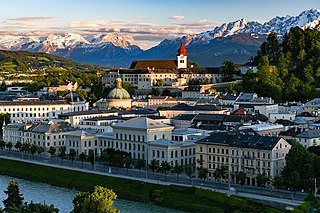
Salzburg is the fourth-largest city in Austria. In 2020, it had a population of 156,872.

Salzburg is an Austrian federal state. In German it is called a Bundesland, a German-to-English dictionary translates that to federal state and the European Commission calls it a province. In German, its official name is Land Salzburg, to distinguish it from its eponymous capital Salzburg City. For centuries, it was an independent Prince-Bishopric of the Holy Roman Empire.

The Salzburg Festival is a prominent festival of music and drama established in 1920. It is held each summer, for five weeks starting in late July, in Salzburg, Austria, the birthplace of Wolfgang Amadeus Mozart. Mozart's operas are a focus of the festival; one highlight is the annual performance of Hofmannsthal's play Jedermann (Everyman).

Hohenwerfen Castle is a medieval rock castle, situated on a 623-metre (2,044 ft) precipice overlooking the Austrian market town of Werfen in the Salzach valley, approximately 40 kilometres (25 mi) south of Salzburg. The fortress is surrounded by the Berchtesgaden Alps and the adjacent Tennen Mountains. Hohenwerfen is a "sister" of Hohensalzburg Fortress, both built by the Archbishops of Salzburg in the 11th century.

The University of Salzburg, also known as the Paris Lodron University of Salzburg, is an Austrian public university in Salzburg municipality, Salzburg State, named after its founder, Prince-Archbishop Paris Lodron.
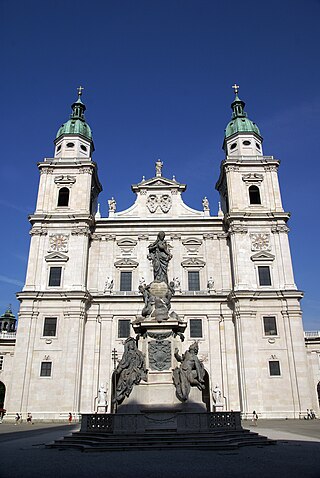
Salzburg Cathedral is the seventeenth-century Baroque cathedral of the Roman Catholic Archdiocese of Salzburg in the city of Salzburg, Austria, dedicated to Saint Rupert and Saint Vergilius. Saint Rupert founded the church in 774 on the remnants of a Roman town, and the cathedral was rebuilt in 1181 after a fire. In the seventeenth century, the cathedral was completely rebuilt in the Baroque style under Prince-Bishop Wolf Dietrich von Raitenau to its present appearance. Salzburg Cathedral still contains the baptismal font in which composer Wolfgang Amadeus Mozart was baptized.

Nonnberg Abbey is a Benedictine monastery in Salzburg, Austria. Founded c. 712/715 by Saint Rupert of Salzburg, it is the oldest continuously existing nunnery in the German-speaking world. The monastery complex is today a protected monument and part of the Historic Centre of the City of Salzburg, a UNESCO World Heritage Site since 1996.
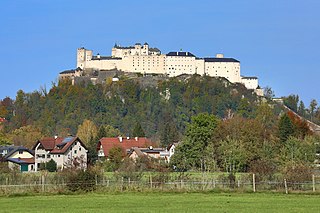
Hohensalzburg Fortress is a large medieval fortress in the city of Salzburg, Austria. It sits atop the Festungsberg mountain at an altitude of 506 m. It was erected at the behest of the prince-archbishops of Salzburg. The fortress is 250 m (820 ft) long and 150 m (490 ft) wide making it one of the largest medieval castles in Europe.
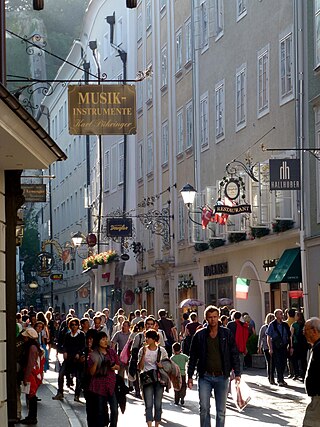
Getreidegasse is a busy shopping street in the historic Altstadt of Salzburg, Austria, a UNESCO World Heritage Site since 1996. It is known for the birthplace of Wolfgang Amadeus Mozart at No. 9, where he lived until the age of 17. The narrow street is characterised by numerous high townhouses side by side with its wrought iron guild signs.

Mirabell Palace is a historic building in the city of Salzburg, Austria. The palace with its gardens is a listed cultural heritage monument and part of the Historic Centre of the City of Salzburg UNESCO World Heritage Site.

The Petersfriedhof or St. Peter's Cemetery is – together with the burial site at Nonnberg Abbey – the oldest cemetery in the Austrian city of Salzburg, located at the foot of the Festungsberg with Hohensalzburg Castle. It is one of Salzburg's most popular tourist attractions.

Festungsberg is a mountain in the city of Salzburg in Austria,, which rises to an elevation of 542 metres (1,778 ft). It is the site of the Hohensalzburg Fortress, which towers over Salzburg's historic city centre to the north, and forms part of the city's UNESCO World Heritage Site.
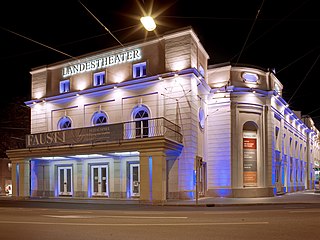
The Salzburg State Theatre is a theatre situated in Salzburg, Austria, a venue for opera, theatre, and dance, contemporary and older works, with resident companies of actors, singers and dancers. The theatre presents approximately 400 performances each season, from September to June. The main theatre building is located next to the Mirabell Gardens and seats an audience of 707. The staff consists of 340 people originating from 35 different countries.

Salome Alt, was the mistress to Wolf Dietrich von Raitenau, reigning Prince-Archbishop of Salzburg, from about 1593 until 1617.

The Hotel Goldener Hirsch is a five-star hotel located at Getreidegasse 37 in the Altstadt of Salzburg, Austria. The hotel includes the adjacent house at Getreidegasse 35 and the nearby goldsmith house at Getreidegasse 46. The Goldener Hirsch is listed as part of the UNESCO World Heritage Site Altstadt Salzburg.
The following is a timeline of the history of the city of Salzburg, Austria.

The Sigmundstor, often still known as the Neutor, is a road tunnel in Salzburg that also forms one of the city gates of the historic Altstadt. It connects the Altstadt with the Riedenburg quarter through the Mönchsberg mountain. Built in the 18th century, it is the oldest road tunnel in Austria.

Mozartplatz, formerly known as Michaelsplatz, is a square in the historic centre of Salzburg in Austria. In the centre of the square is a statue in memory of the composer Wolfgang Amadeus Mozart, who was born in the city and after whom the square is now named.

Altenau Palace was a palace in Salzburg, Austria. Built in 1606, it was demolished in the 1720s to make way for the Mirabell Palace which stands on the same site. It was the home of prince-archbishop Wolf Dietrich von Raitenau.





















